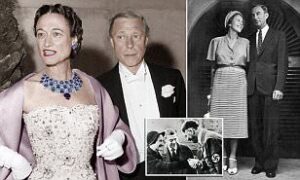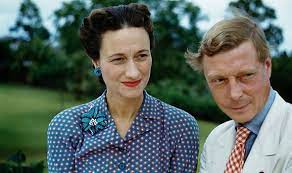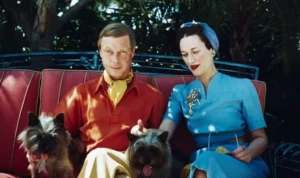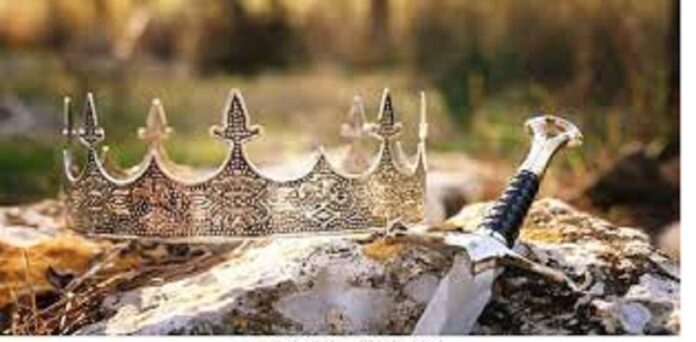The True-Life Story Of King Edward VIII; The British King, Who Gave Up His Throne For Love.
Hello Lively Stones,
Before Prince Harry and Megan Markle, there was King Edward VIII and Wallis Warfield (also known as Wallis Simpson). And theirs was an astonishing love story, perhaps the most intriguing albeit controversial love story of historical figures ever told, since the days of the Mark Anthony/Queen Cleopatra/Julius Caesar love triangle.
The story of a British king, who gave up his throne to marry his American sweetheart (who had divorced her first husband and was seeking a divorce from her second), sounds more like those fairy tales from kid’s storybooks. Little wonder, then, that in those days, kids in the UK sang a favourite playground song,
“Hark, the Herald Angels sing, Mrs Simpson’s pinched our king“.
But it did happen, and the year was 1936.
Part l:
“This boy will ruin himself within twelve months after I’m dead.”
That was the prediction King George V made about his son and successor, Edward (later Edward VIII). The King was troubled by rumours of his young son’s countless dalliances with women, both at home in the UK and away in foreign nations.
Now, whether Edward did ruin himself, just like his father predicted or not, for choosing love over a throne is a question that demands a subjective answer. But there is little doubt that his renunciation of the British throne and his subsequent abdication to marry Wallis Warfield, attracted much negative publicity to the British Royal family, as it painted a picture of disunity and chaos in the ‘House of Windsor’ (as the British Royal family is known).
Edward VIII (Edward Albert Christian George Andrew Patrick David) was born into the British royal family on 23 June 1894 at White Lodge, Richmond, Surrey. As the eldest child of the Duke and Duchess of York, later King George V and Queen Mary, he was third in the line of succession to the throne after his grandfather (Edward VII), and father (George V), at the time of his birth. Edward was born during the reign of his great-grandmother, Queen Victoria (the grandmother of Europe). He was affectionately known as David by his family.
The young Edward spent most of his childhood confined to his father’s York Castle home. He and his siblings were tutored by various nannies and guardians. Edward attended the naval academy at Osborne on the Isle of Wight from 1907 to 1909. The boy-prince was embarking on his transition to adulthood. In 1909, Edward proceeded to the Royal Naval College at Dartmouth. He was also at Magdalen College, Oxford, between 1912 to 1914.
Edward’s father, the Duke of York ascended the throne as King George V upon King Edward VII’s death on 6 May 1910, and Edward was now the heir-apparent to the British throne. He was created Prince of Wales and the Earl of Chester on 23 June 1910, his 16th birthday.
Edward was formally invested as Prince of Wales on 13 July 1911 at Caernarfon Castle in Wales. The first test of personality for the young heir-apparent probably occurred at the outset of the first world war in 1914, as Edward, who had come to the age of fighting, volunteered to fight in the war. It was a brave and patriotic offer from the heir-apparent, but, the secretary of war, Lord Kitchener, was having none of that, hinting at the colossal grief that would arise in the British Empire if the enemy captured the heir apparent. Nonetheless, Edward was a regular visitor to the front lines. Such visits made him a troop’s favorites. He received the ‘Military Cross’ in 1916. After the war, Edward embarked on many royal visits on behalf of his father, both at home and abroad. And with his boyish good looks and royal status, he enjoyed much popularity wherever he went.
But patriotic war efforts and royal duties were not the only hallmarks of Edward’s youthful years. There were also his much-publicised romantic relationships with women.
More From Lively Stones:Prince Harry and Meghan Markle pay surprise visit to Queen in UK two years after stepping down as senior royals
Edward was the quintessential playboy prince of his time. As early as 1917, he was already romantically involved with a French courtesan, Marguerite Alibert. They met on one of his many trips to Paris during the war, and he became infatuated with her. However, after about a year, Edward abruptly ended the relationship. He dated other patrician ladies: Portia Cadogan, Marion Coke, Freda Dudley Ward, Rosemary Leveson-Gower, and most notably Lady Thelma Furness, who introduced him to his femme fatale, Wallis Warfield.
Born on 19 June 1896 at Blue Ridge Summit, Pennsylvania. Wallis was the only child of her parents. Her father was Teackle Wallis Warfield, a renowned flour Merchant, and her mother was Alice Montague. Wallis and her mother depended on the charities of friends and relatives after her father’s death from Tuberculosis on 15 November 1896. Wallis was educated at Oldfields College, Maryland, between 1912 to 1914. As a student, she was considered bright, witty and always well-dressed. In her own words;
“I’m not a beautiful woman. I’m nothing to look at, so the only thing I can do is dress better than anyone else.”
One of her biographers seemed to buttress her points when he wrote:
“Though Wallis’s jaw was too heavy to be counted beautiful, her fine violet-blue eyes and petite figure, quick wits, vitality and capacity for total concentration on her interlocutor ensured that she had many admirers”.
Wallis married her first husband, Earl Winfield Spencer Jr, a US Navy aviator, on 8 November 1916, at Christ Episcopal Church in Baltimore. Theirs was a much-troubled marriage, as Spencer was known as a heavy drinker, and the couple lived separately on several occasions. Wallis was rumoured to have dated an Argentine diplomat, Felipe de Espil, within this period of constant separations and reunions with her erstwhile husband. After eleven years of marriage, their divorce was finalised on 10 December 1927.

Seven years after her first divorce, Wallis married Ernest Aldrich Simpson, an Anglo-American shipping executive, on 21 July 1928 at the Register Office, London. At first, the couple lived well above means with a retinue of domestic staff, and Ernest’s shipping business was booming. But, theirs was a dying marriage, as Ernest later became engaged in a losing battle with financial difficulties following the Stock Market Crash of 1929.
Then, on 30 January 1934, at Burrough Court, near Melton Mowbray, Leicestershire, Lady Thelma introduced Edward to the Still-married Wallis.
And a great romance story was born.

Edward and Wallis met on several occasions after their introduction. In January 1934, Lady Furness, who at that time was still romantically involved with Edward, travelled to New York. And while she was away, Wallis wasted no time ousting her and establishing herself as Edward’s undisputable numero uno.
By the end of 1934, Prince Edward was so irretrievably obsessed with Wallis, that in the words of his official biographer, he became “slavishly dependent” on her. He treated her like a fairy-tale princess, catering to her every whim. In 1935, he holidayed with her in Europe. He surely doted on her.
Edward even went as far as introducing Wallis to his parents, King George V and Queen Mary, at an evening event in Buckingham Palace. He was in love with Wallis, no doubt. But his father was unimpressed with her, as divorcees were generally unwelcome in British royal circles. Perhaps, Edward had wished his father would respect his choice of a wife like parents respect their children’s choices in America. Unsurprising then, that he once remarked;
“The thing that impresses me most about America is the way parents obey their children.”
It wasn’t only Edward’s father that rejected Wallis. The then-British prime minister, Stanley Baldwin, and other British elites all rejected her as well. They were all concerned about the significant influence and control that she exerted on the heir apparent to the British throne. They must have asked themselves and any other person who cared enough to listen; How on Earth will an American divorcee be the next British queen consort? How will the people of the British Empire take such absurdity? And what sort of Lady is this Wallis woman?
“Soon, I shall be Queen of England.” Wallis reportedly made this statement after Edward ascended the throne as King Edward VIII, upon the death of his father, King George V; who died on 20 January 1936 at Sandringham.
As the new British Monarch, Edward continued his affair with Wallis. The couple cruised the Eastern Mediterranean on the steam yacht Nahlin during the late summer of 1936. By early November 1936, it was increasingly becoming crystal clear to those in the British Establishment that Edward meant business with this Wallis woman.
Then Edward decided to take the bull by the horns. He invited Prime Minister Baldwin on 16 November 1936, and notified him of his intentions to marry Wallis when she became free to marry again. Baldwin reminded him that the ‘Church of England’, of which he, the King, was the titular head, would never sanction the remarriage of divorced persons if their former spouses were still alive (until 2002). The prime minister further opined that the British public would adjudge the proposed marriage to be politically, unconstitutionally, morally, and socially unjust. And that the British Populace would never embrace Wallis as their queen consort. Edward remained unrelenting.
To bypass the impasse, Edward proposed a Morganatic Marriage; one in which he would remain King, but Wallis would not become queen consort, enjoying only lesser privileges. And any child born to them would not inherit the throne. It was indeed a masterstroke of a proposal from the desperate King. However, the British parliament, with the governments of most British dominions, particularly Australia, Canada and South Africa, all rejected the proposal.

And where was Wallis, when this chaotic abdication crisis was going on? By early December 1936, her affair with the King had become public knowledge in the UK. As expected, the British public were captivated with the story. And the ever-powerful British press was increasingly becoming fixated on the intriguing affair. Thus, in a dramatic race against time to be free of the British Press, Wallis fled the UK to the South of France, where she holed up in the Villa Lou Viei; the heome of her close friends, Herman and Katherine Rogers. But like a pack of bloodhounds, the press still hounded her for months.
Then, the Prime minister presented three options to Edward: give up the idea of marrying Wallis for good, marry against your ministers’ wishes, or abdicate. Edward was neither prepared nor willing to give up his beloved Wallis, so the first option was out of the question. And being fully aware that the government would resign, prompting an unprecedented constitutional crisis, if he married against their wishes. King Edward VIII chose the next available option that stunned the world and remained a stuff of legend to this day.
To be continued….. tommorow
Do you have a story to share? We want to hear all about it. Email us at [email protected] or Whatsapp +2348029870309
Share This So Many Can See And Learn From Your Experience.



